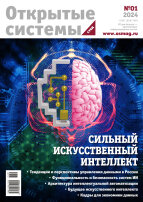.jpg)
OSJ FORECAST
Digitalization with a Human Face: OSJ Big Seven Forecasts, v. 2020
The Open Systems Journal.DBMS offers its seven technology development forecasts for 2020. The unifying trend of our predictions for the coming year is the impact digital innovation makes on human lives.
Natalya Dubova (dubova@osp.ru), science editor, Open Systems Journal.DBMS (Moscow).
COVER FEATURES
SMART SECURITY
Securing IoT Apps
Users increasingly rely on Internet of Things (IoT) apps to manage their digital lives through the overwhelming diversity of IoT services and devices. Are the IoT app platforms doing enough to protect the privacy and security of their users? By securing IoT apps, how can we help users reclaim control over their data?
Musard Balliu (musard@kth.se), assistant professor, KTH Royal Institute of Technology; Iulia Bastys (bastys@chalmers.se), doctoral student, Andrei Sabelfeld (andrei@chalmers.se), professor, Chalmers University of Technology.
Toward Automated Firmware Analysis in the IoT Era
Firmware for Internet of Things devices can contain malicious code or vulnerabilities, which have already been used in devastating attacks. In this article, we discuss the problems in analyzing firmware for security, offer case studies, and propose challenge tasks to improve firmware analysis.
Dave Jing Tian (daveti@purdue.edu), assistant professor, Purdue University; Tuba Yavuz (tuba@ece.ufl.edu), assistant professor, Patrick Traynor (traynor@ufl.edu traynor@ufl.edu), professor, Grant Hernandez (grant.hernandez@ufl.edu), Ph.D. candidate, Kevin R.B. Butler (butler@ufl.edu), associate professor, Farhaan Fowze (farhaan104@ufl.edu), Ph.D. candidate, University of Florida.
Security Engineering for Machine Learning
Artificial intelligence is in the midst of a popular resurgence in the guise of machine learning (ML). Neural networks and deep learning architectures have been shown empirically to solve many real-world problems. We ask what kinds of risks ML systems pose in terms of security engineering and software security.
Gary McGraw (gem@garymcgraw.com), cofounder; Richie Bonett (richiebonett@gmail.com), Harold Figueroa (harold.figueroa@gmail.com), Victor Shepardson (victor.shepardson@gmail.com), research scientists, Berryville Institute of Machine Learning.
Using Edge AI to Control Manufacturing Equipment
Increasingly employed to improve manufacturing processes, the Edge AI approach helps strengthen cyberattack protection of industrial systems while increasing their performance, all of that with relatively low programming effort.
Victor Popov (vp282@cornell.edu), data science, Open Analytics (Chicago, USA).
PLATFORMS
Real-Time Object-Based Video Analytics
Using systems based on Edge AI concept enables to implement neural network inference for object-based video analytics tasks right where the data is collected.
Ilya Dushin (dushin@combox.io), executive director, Viacheslav Tikhomirov (tikhomirov@combox.io), expert, Combox Technology (St. Petersburg).
BIG DATA
Three Steps to Data-Centric Architecture
A data-centric architecture offers ways to eliminate integration challenges, accelerate new application development, adapt legacy software, and get hold of game changing analytic tools.
Sergei Gorshkov (serge@trinidata.ru), director, TriniData (Yekaterinburg).
Universal Data Management Platform
A universal platform for building data management systems could support general data quality assurance functions along with integrity and relevance control, as well as enable customization to data of a specific enterprise.
Roman Strekalovsky (roman.strekalovskiy@unidata-platform.ru), lead architect, Unidata (St. Petersburg).
SOFTWARE ENGINEERING
Validation of Autonomous Systems
Society today depends on autonomous systems, such as intelligent service systems, self-driving trains, and remote surgeries. The ultimate validation of the Turing test is that we often do not recognize autonomous systems. This growing usage poses many challenges, such as how to provide transparency, which rules or learning patterns are applied in a complex situation, and if these rules are the right ones. Validation is the key challenge, of which we will provide an overview in this article.
Christof Ebert (christof.ebert@vector.com), managing director, Vector Consulting Services; Michael Weyrich (michael.weyrich@ias.uni-stuttgart.de), director of the Institute of Industrial Automation and Software Engineering, University of Stuttgart.
OS ACADEMY
Victor Ivannikov: Randomness and a Pattern
To work and to pass the knowledge to younger generations — that is how Viktor Ivannikov, who was one of Russia’s leading computer scientists, saw his patriotic duty. On February 27, 2020, he could turn 80.
Dmitry Volkov (vlk@keldysh.ru), fellow, Keldysh Institute of Applied Mathematics; Leonid Karpov (mak@ispras.ru), lead scientist, V.P. Ivannikov Institute for Systems Programming (Moscow).
Professional Process Management Standard
Process Management Professional is Russia's first-ever BPM certification that has been recently created.
Yulia Wagner (operations@abpmp.org.ru), VP, Business Association of Business Process Management Professionals (Moscow).
LIBRARY
Technological Synergy
The September, October and November Issues of Computer Magazine (IEEE Computer Society, Vol. 52, No. 9–11, 2019) cover translational computing, ARPANET semicentenary and digital healthcare subjects.
Andrei Nikolayenko (ANikolaenko@Ibs.ru), architect, IBS (Moscow).
A Guide to Data Management
With digital transformation requiring a rethinking of data management approaches and the data notion itself, the second edition of DAMA International’s Guide to the Data Management Body of Knowledge (DAMA-DMBOK2) serves just the purpose.
Dmitry Volkov(vlk@keldysh.ru), fellow, Keldysh Institute of Applied Mathematics (Moscow).
